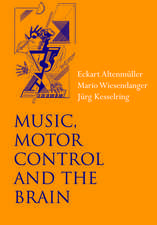Societies of Brains: A Study in the Neuroscience of Love and Hate: INNS Series of Texts, Monographs, and Proceedings Series
Autor Walter J. Freemanen Limba Engleză Paperback – mar 1995
* how and why people fall in and out of love;
* the biological basis for experiencing feelings of love and hate; and
* how music and dance have provided the ancestral technology for forming social groups such as tribes and clans.
The author reviews the history of the mind-brain problem, and demonstrates how the new sciences of behavioral electrophysiology and nonlinear dynamics -- combined with the latest computer technology -- have made it possible for us to observe brains in action. He also provides an answer to the question: What happens to a stimulus after it enters the brain? The answer: The stimulus triggers the construction of a percept and is then washed away. All that we know is what our brains construct for us by neurodynamics. Brains are not logical devices that process information. They are dynamical systems that create meaning through interactions with the environment -- and each other.
The book shows how the learning process by which brains construct meaning tends to isolate brains into self-centered worlds, and how nature has provided a remedy -- first appearing in mammals as a mechanism for pair-bonding -- to ensure reproduction of the young dependent on parents. The remedy is based in the neurochemistry of sex which serves to dissolve belief structures in order to open the way for new patterns of understanding and behavior. Individuals experience these changes in various ways, such as falling in love, collegiate indoctrination, tribal bonding, brain washing, political or religious conversions, and related types of socialization. The highest forms of meaning for humans come through these social attachments.
| Toate formatele și edițiile | Preț | Express |
|---|---|---|
| Paperback (1) | 412.37 lei 43-57 zile | |
| Taylor & Francis – mar 1995 | 412.37 lei 43-57 zile | |
| Hardback (1) | 1002.80 lei 43-57 zile | |
| Taylor & Francis – apr 1995 | 1002.80 lei 43-57 zile |
Preț: 412.37 lei
Nou
Puncte Express: 619
Preț estimativ în valută:
78.91€ • 82.59$ • 65.68£
78.91€ • 82.59$ • 65.68£
Carte tipărită la comandă
Livrare economică 31 martie-14 aprilie
Preluare comenzi: 021 569.72.76
Specificații
ISBN-13: 9780805820171
ISBN-10: 0805820175
Pagini: 216
Ilustrații: Illustrations
Dimensiuni: 152 x 229 x 14 mm
Greutate: 0.36 kg
Ediția:1
Editura: Taylor & Francis
Colecția Psychology Press
Seria INNS Series of Texts, Monographs, and Proceedings Series
Locul publicării:Oxford, United Kingdom
ISBN-10: 0805820175
Pagini: 216
Ilustrații: Illustrations
Dimensiuni: 152 x 229 x 14 mm
Greutate: 0.36 kg
Ediția:1
Editura: Taylor & Francis
Colecția Psychology Press
Seria INNS Series of Texts, Monographs, and Proceedings Series
Locul publicării:Oxford, United Kingdom
Public țintă
ProfessionalCuprins
Contents: Prologue. Brains and Minds. Nerve Energy and Neuroactivity. Sensation and Perception. Intention and Movement. Intentional Structure and Thought. Learning and Unlearning. Self and Society.
Recenzii
"Societies of Brains is a quite exceptional book and should be a 'must' on the reading list of every reader of this journal."
—Psychological Medicine
"In this essay, written for the occasion of the Spinoza lectures of the University of Amsterdam, Walter Freeman introduces the new concept of 'neuroactivity,' which is defined as the structure of brain operations that forms the interface between the electrochemical signs of neuronal populations and overt, measured behaviors. While rejecting the dualistic view of mind and brain, he sets the stage for an inquiry into how causality arises in brain functions by exploring how neuroactivity relates both to brain and to mind. The pivotal concept of neuroactivity is that to understand brain functions, it is essential to take into account the dynamics of neuronal populations and not just the behavior of single neurons. Based on a life-long series of exciting experimental findings aimed at unraveling the dynamics of neuroactivity in space and time, Freeman speculates about how sensation and perception, intention and movement, intentional structure and thought, learning and unlearning come about. Intrinsic to Freeman's analysis of the signals generated by the neuronal networks of the brain (i.e. EEGs) is his conviction that within the apparent unreproducibility and unpredictability of EEG signals, there may be a hidden chaotic determinism, although he admits the difficulties in measuring chaos in such brain signals. In his view this makes the theory of nonlinear dynamics, despite its difficulties and limitations, the best available new tool for exploring brain function.
In this essay, Freeman underscores the importance of theoretical concepts in acquiring insight into the functions of the brain. Although he leaves the reader with a lot of questions regarding how to assess his new concepts and test his predictions, this essay offers plenty of spicy food for critical thought. Spinoza would have eagerly appreciated being confronted with Freeman's challenges."
—Fernando H. Lopes da Silva, M.D., Ph. D.
Director, Institute of Neurobiology, University of Amsterdam
"How does the brain work? If you are interested in this question, you must read Walter Freeman, for he has taken the high ground with his empirically based, chaos-mathematical model. This is a clearly written book by a great pioneer about his monumental breakthrough."
—Ralph Abraham
Professor of Mathematics, University of California, Santa Cruz
"Walter Freeman's book is uniquely valuable as a personalized statement of the views of a real pioneer and a global theorist with solid experimental roots. One doesn't need to agree with every flavor in the bouillabaisse to enjoy and learn and think of the next experiment."
—Theodore H. Bullock
Professor of Neurosciences, University of California at San Diego
"In this fascinating book, a pioneer of brain research gives deep insights into brains and minds and encourages the reader to explore further the utility of synergetics and nonlinear dynamics for understanding brain function."
—Hermann Haken
Professor of Physics, Institute for Theoretical Physics and Synergetics, Univers
"As fields of knowledge become more diversified it becomes more difficult and more daring to attempt a synthesis. Nonetheless, Walter Freeman offers a unique perspective on issues in psychology, artificial intelligence, literature, philosophy and medicine organized around his unorthodox but convincing account of how the brain uses chaotic dynamics to enable animals like us to cope with their environment. The result is an original and wide-ranging book, full of fascinating facts and wry wisdom. It casts grave doubts on the reigning paradigm in neuroscience and cognitivism and gives researchers in the human sciences a controversial new theory of the emotions and of human social bonding."
—Hubert L. Dreyfus
University of California at Berkeley, author of What Computers Still Can't Do
—Psychological Medicine
"In this essay, written for the occasion of the Spinoza lectures of the University of Amsterdam, Walter Freeman introduces the new concept of 'neuroactivity,' which is defined as the structure of brain operations that forms the interface between the electrochemical signs of neuronal populations and overt, measured behaviors. While rejecting the dualistic view of mind and brain, he sets the stage for an inquiry into how causality arises in brain functions by exploring how neuroactivity relates both to brain and to mind. The pivotal concept of neuroactivity is that to understand brain functions, it is essential to take into account the dynamics of neuronal populations and not just the behavior of single neurons. Based on a life-long series of exciting experimental findings aimed at unraveling the dynamics of neuroactivity in space and time, Freeman speculates about how sensation and perception, intention and movement, intentional structure and thought, learning and unlearning come about. Intrinsic to Freeman's analysis of the signals generated by the neuronal networks of the brain (i.e. EEGs) is his conviction that within the apparent unreproducibility and unpredictability of EEG signals, there may be a hidden chaotic determinism, although he admits the difficulties in measuring chaos in such brain signals. In his view this makes the theory of nonlinear dynamics, despite its difficulties and limitations, the best available new tool for exploring brain function.
In this essay, Freeman underscores the importance of theoretical concepts in acquiring insight into the functions of the brain. Although he leaves the reader with a lot of questions regarding how to assess his new concepts and test his predictions, this essay offers plenty of spicy food for critical thought. Spinoza would have eagerly appreciated being confronted with Freeman's challenges."
—Fernando H. Lopes da Silva, M.D., Ph. D.
Director, Institute of Neurobiology, University of Amsterdam
"How does the brain work? If you are interested in this question, you must read Walter Freeman, for he has taken the high ground with his empirically based, chaos-mathematical model. This is a clearly written book by a great pioneer about his monumental breakthrough."
—Ralph Abraham
Professor of Mathematics, University of California, Santa Cruz
"Walter Freeman's book is uniquely valuable as a personalized statement of the views of a real pioneer and a global theorist with solid experimental roots. One doesn't need to agree with every flavor in the bouillabaisse to enjoy and learn and think of the next experiment."
—Theodore H. Bullock
Professor of Neurosciences, University of California at San Diego
"In this fascinating book, a pioneer of brain research gives deep insights into brains and minds and encourages the reader to explore further the utility of synergetics and nonlinear dynamics for understanding brain function."
—Hermann Haken
Professor of Physics, Institute for Theoretical Physics and Synergetics, Univers
"As fields of knowledge become more diversified it becomes more difficult and more daring to attempt a synthesis. Nonetheless, Walter Freeman offers a unique perspective on issues in psychology, artificial intelligence, literature, philosophy and medicine organized around his unorthodox but convincing account of how the brain uses chaotic dynamics to enable animals like us to cope with their environment. The result is an original and wide-ranging book, full of fascinating facts and wry wisdom. It casts grave doubts on the reigning paradigm in neuroscience and cognitivism and gives researchers in the human sciences a controversial new theory of the emotions and of human social bonding."
—Hubert L. Dreyfus
University of California at Berkeley, author of What Computers Still Can't Do
























